Orthognatic Camouflage in Washington, DC
Orthognathic camouflage refers to techniques Dr. Baker uses to normalize facial form in patients who ideally would benefit from orthognathic surgery but do not desire or cannot undergo jaw surgery to correct their skeletal dysplasia. Orthognathic camouflage techniques are also used to correct aesthetic concerns in patients who previously underwent a nonsurgical orthodontic treatment despite their underlying jaw disharmony. These patients typically report that were unaware of the aesthetic consequences and now return to normalizing or enhancing facial form, proportion, projection, or facial shape.
Patients with an underlying skeletal deformity who undergo nonsurgical dental compensation for correction of their malocclusion may present later in life with aesthetic concerns about their facial appearance directly related to the uncorrected skeletal jaw anomaly. Many patients would be frustrated to hear that to address their concerns they would require orthodontic dental decompensation followed by orthognathic surgery. Thus, these patients often seek alternatives to achieve normal facial proportion, shape, and soft tissue support.
Orthognathic camouflage in Washington, DC refers to Dr. Baker’s use of procedures, other than traditional orthognathic surgery, to correct the facial dysmorphology created by an underlying skeletal discrepancy that is mild to moderate in the degree of severity. Orthognathic camouflage procedures include dermal fillers, genioplasty, rhinoplasty, facial implants, fat grafting, and surgical lip lifts. Indications for camouflage procedures include patients who had skeletal orthodontic problems treated with nonsurgical orthodontics. This approach corrects the malocclusion, but the patient’s facial imbalance persists. These techniques can also be used for patients with hemifacial microsomia, post-traumatic jaw deformity, or an iatrogenic deformity from previous surgery.
The most common indication for a camouflage procedure is that of an underlying skeletal malocclusion that has been treated with dental compensation. Dental compensation can be used to treat Class II or III malocclusions without surgery in many cases. However, to make room to align the teeth in a Class I position, other teeth may need to be extracted. It is important to have a discussion with the patient about the underlying etiology of their facial aesthetic concerns, such as jaw imbalance, and discuss the indications for orthognathic surgery if orthognathic camouflage is not a viable option for their severe skeletal discrepancy.
Skeletal Class II Deformity (Overbite)
Underdevelopment of the lower jaw leading to a Class II malocclusion (overbite) is the most common skeletal discrepancy. Ideally, treatment consists of lower jaw advancement with or without genioplasty. However, many of these patients seek orthodontic treatment in their early teens and the thought of surgery seems overly aggressive at the time. Therefore, the orthodontist will typically offer a treatment that can achieve a Class I occlusion without the need for surgery. To align the teeth when a Class II malocclusion exists, premolars are frequently extracted in the upper arch allowing the anterior teeth to be posteriorly positioned. As the upper teeth tilt posteriorly, the lip support retracts posteriorly as well. Given that the original underlying abnormality is a small lower jaw, the patient now presents with a small lower jaw and chin as well as a retracted upper lip. The loss of upper lip support compounded by a small lower jaw frequently gives the appearance of a large nose even when nasal dimensional analysis shows nasal 20 dimensions are within normal limits. Although the orthodontist has achieved an excellent
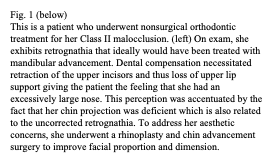 The dentally compensated Class II patients represent a large percentage of those who present to the surgeon’s office to reduce their “big” nose, increase their chin projection, or address an obtuse cervicomental angle. The number of patients presenting for chin augmentation and reduction rhinoplasty demonstrates the frequency with which this situation occurs. Chin augmentation is performed to create the appearance of a normal nose-to-chin relationship without the need for jaw surgery; implying that advancement of the chin may make the “large” nose appear aesthetically proportional. In cases where the patient feels that their nose is too large despite chin advancement, a rhinoplasty is performed in addition to chin advancement (Figure 1a-d).
The dentally compensated Class II patients represent a large percentage of those who present to the surgeon’s office to reduce their “big” nose, increase their chin projection, or address an obtuse cervicomental angle. The number of patients presenting for chin augmentation and reduction rhinoplasty demonstrates the frequency with which this situation occurs. Chin augmentation is performed to create the appearance of a normal nose-to-chin relationship without the need for jaw surgery; implying that advancement of the chin may make the “large” nose appear aesthetically proportional. In cases where the patient feels that their nose is too large despite chin advancement, a rhinoplasty is performed in addition to chin advancement (Figure 1a-d).
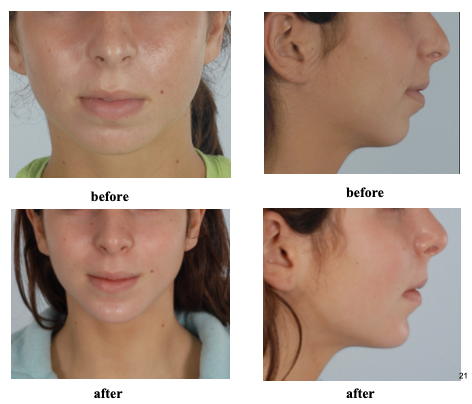
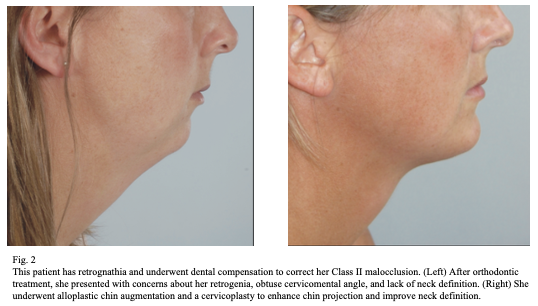
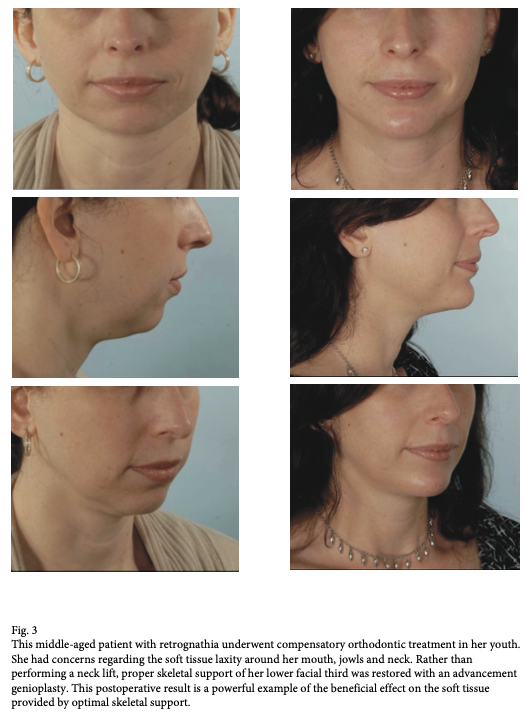

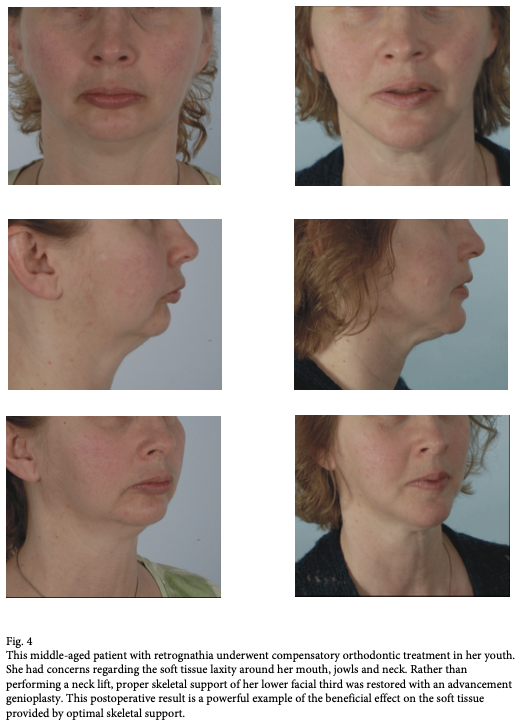
Skeletal Class III Deformity (Underbite)
Camouflage is also an option for patients who present with a dentally compensated Class III skeletal relationship. On physical examination, the entire face is evaluated. The projection of the infra-orbital rims should be evaluated to see if they lack projection creating a negative vector globe relationship. The midface and peri-alar areas are evaluated next. A typical presentation includes
deep alar grooves, shallow midface projection, and deep nasolabial creases. The chin is assessed next to see if it is projecting beyond the lower lip. Although the deficiency lies in the midface, a strong chin that is posteriorly positioned can soften the degree of midface retrusion when managed with midface camouflage.
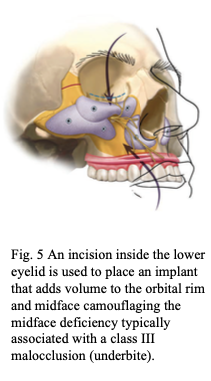 Surgical options to camouflage the dentally compensated skeletal Class III relationship include the use of alloplastic implants, fat grafting, and dermal fillers. If a shallow orbital rim is present and there is a negative vector that concerns the patient, a transconjunctival incision can be made and an inferior orbital rim implant can be placed adding projection to the rim. Dr. Baker prefers a transconjunctival incision with cantholysis laterally with a slight skin extension into a crease near the crow’s feet. This offers ample exposure to place a polyethylene implant along the inferior orbital rim. The implant is secured with 1 or 2 self-drilling titanium screws that are placed posterior to the rim on the anterior portion of the orbital floor to minimize palpation by the patient. The use of a trans- conjunctival incision with reattachment of the canthus is well concealed and results in good symmetry of the lower lid (Fig. 5).
Surgical options to camouflage the dentally compensated skeletal Class III relationship include the use of alloplastic implants, fat grafting, and dermal fillers. If a shallow orbital rim is present and there is a negative vector that concerns the patient, a transconjunctival incision can be made and an inferior orbital rim implant can be placed adding projection to the rim. Dr. Baker prefers a transconjunctival incision with cantholysis laterally with a slight skin extension into a crease near the crow’s feet. This offers ample exposure to place a polyethylene implant along the inferior orbital rim. The implant is secured with 1 or 2 self-drilling titanium screws that are placed posterior to the rim on the anterior portion of the orbital floor to minimize palpation by the patient. The use of a trans- conjunctival incision with reattachment of the canthus is well concealed and results in good symmetry of the lower lid (Fig. 5).
Other approaches to inferior orbital rim deficiency include fat grafting or dermal filler. It is Dr. Baker’s preference to avoid autologous fat grafting in this area given the thin tissue that is associated with this anatomic region. The margin for error between adequate fill and visible irregularities that are perceivable to touch and feel to the patient is small. If soft tissue filler is to be used, Dr. Baker prefers using hyaluronic acid.
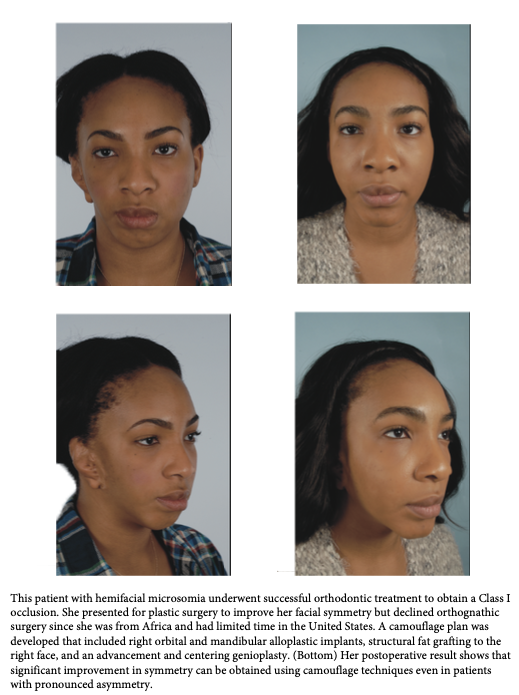
Midface deficiency is treated with dermal fillers or the insertion of alloplastic implants. The advantage of an implant is that it is permanent, but has greater use for more pronounced deficiencies and requires the patient to be willing to undergo surgery. Alternatively, dermal fillers allow for more subtle degrees of augmentation, increased precision, reversibility, and the option to avoid surgery.
Alloplastic implants are a useful tool in midface camouflage. Implants come in a variety of shapes and sizes and can be tailored to the specific needs of the individual. Placement is usually done through an intraoral incision, and the implant is then secured with 2 titanium screws to prevent rotation as well as to affix the implant directly to the bone. Firmly securing the implant to the bone eliminates any space between the implant and the bone, improving the accuracy of the result (Fig. 5).
Summary
It is normal for a young patient with a skeletal jaw anomaly to be reluctant to undergo surgery but not uncommon for them to present later in life for procedures to correct the unintended adverse aesthetic consequences of a compensatory approach to a surgical problem. Although the patient has likely completed his or her orthodontic treatment years earlier, the orthodontist may encounter a former patient with these concerns. It is hoped that the reader has an increased appreciation of the orthognathic camouflage options available to patients with uncorrected dentofacial deformities who have concerns related to their facial appearance.
How Much Does Orthognathic Camouflage Cost?
The overall cost of an Orthognathic Camouflage in Washington, DC is affected by anesthesia fees, hospital fees, post-surgery garments, and medications. Price is also impacted by medical tests, surgeon’s fees, and the exact techniques employed.
Schedule a Consultation
To learn more about the treatment of Orthognathic Camouflage in Washington, DC, contact us and schedule a consultation with board-certified plastic surgeon Dr. Baker.
Related Procedures
As Featured In






